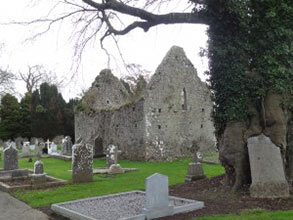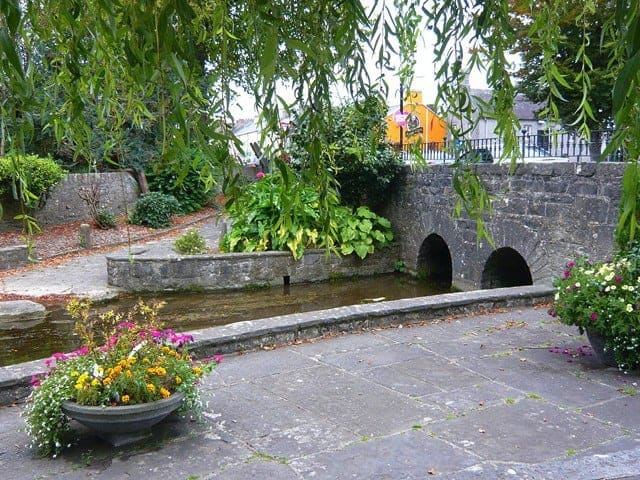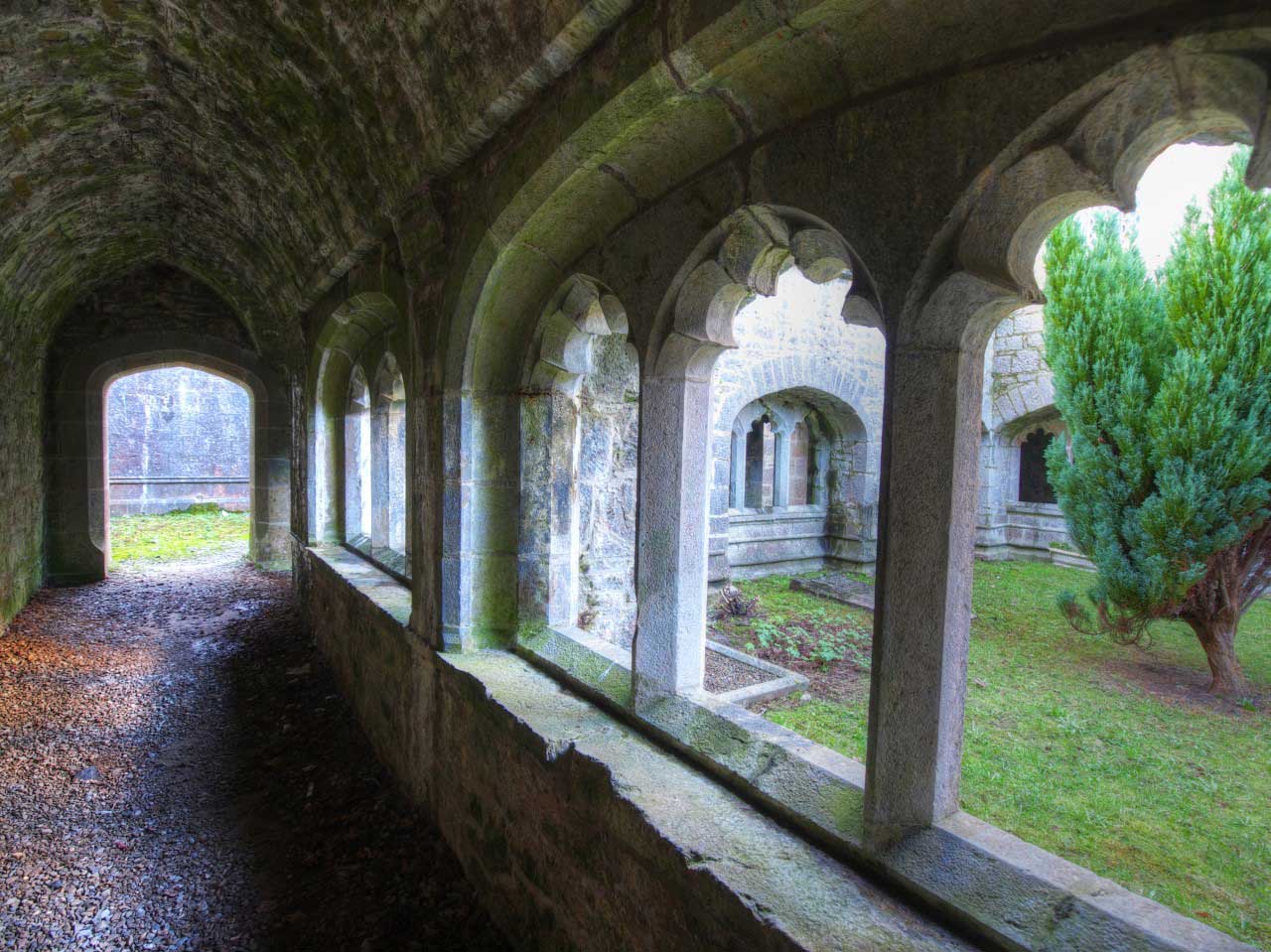History & historic sites
Adare, a designated Heritage Town, is one of the prettiest and friendliest villages in Ireland. It was founded in the 13th Century on the river Maigue.
For the full list of historic sites click here.
History & historic sites
Plan your Adare History & Historic Sites

An architectural wealth of scenic beauty
The main street is punctuated with beautiful stone buildings, medieval monasteries, ruins and a picturesque village park.

Desmond Castle
The Desmond Castle,built in the 13th Century, is located on the edge of the village of Adare, just off the N21 on the main Limerick to Kerry road.

The Franciscan Friary
The Franciscan friary of Adare lies in the demesne of Adare Manor on the east bank of the river Maigue opposite the medieval castle of the earls of Desmond. Access through the Golf Course.

The Holy Trinity Abbey
Situated next to the Adare Heritage Centre, this is the only recorded Trinitarian monastery in Ireland. Founded by Geoffrey de Marisco in 1230 for the Trinitarian Order it was their only Irish house.

The Augustinian Priory
Just a short walk from the village towards Limerick City on the banks of the river Maigue, the priory was founded by the Earls of Kildare in the early 14th century. It was renovated during the early part of the 19th century.

St. Nicholas Old Graveyard
St. Nicholas Old Graveyard is located beside Adare Manor Golf Club, on the outskirts of the village. Within the graveyard is the old parish church of St. Nicholas, and several members of the Dunraven family are buried here.

The Dovecote
This freestanding circular-plan dovecote or columbarium was rebuilt c. 1850, incorporating fabric of an earlier structure, possibly dating from the mid fourteenth century. It has a domed slate roof with cut stone eaves course and rubble limestone walls, a camber-headed opening with cut stone voussoirs and a cast-iron gate and interior walls with square-headed recesses.

The Washing Pool
The small pool in the centre of the village is formed by a tributary of the river Maigue and this was the traditional place for the women of Adare to wash their family clothes. It was also used as a watering place for animals. Across the road from the Washing Pool is a stone fountain erected by Caroline, Countess of Dunraven in 1855.

Wesley Stone
John Wesley, Founder of the Methodist Church, preached to the people of Adare in 1756 from the shade of an ash tree close to the Franciscan Friary. This tree was still there until about 1860. Today a stone marks the site of this tree, and the Methodists hold a ceremony here every June.

Lantern Lodge
The Lantern Lodge is sited at the roundabout as you approach Adare from Limerick city. This handsome Victorian Gothic Gate Lodge previously gave access to Adare Manor estate. The building is an important architectural contribution to the heritage of Adare and has recently been carefully restored by the owners of Adare Manor Hotel.

The Bridge
The Bridge over the river Maigue was built by Gerald, fifth Earl of Kildare, whose earldom extended from 1390 to 1410. It was built between those two dates. The original bridge was extremely narrow and barely wide enough for a cart to pass by. You cross this bridge coming from Limerick.

Village Hall
The Village Hall stands at the top of the main street, which is the shopping area for the village. It is built on the site of the old fairgreen and was designed by the Architect, W.Clifford Smith, and was first commissioned in 1909. It is constructed in an English Tudor style.(Artwork by Lilias Conroy, with permission Draíocht, Adare).

Adare's Thatched Cottages
In the early 19th century, the Earl of Dunraven laid the plans for the existing streets and townhouses of Adare. The original thatched cottages were built in the 1820’s, and these were the homes of people employed on the Dunraven Estate.

Architectural Heritage
The information provided on each of these historical sites is concise and described in a very simple form to give visitors an insight into Adare’s proud heritage. For additional information we recommend a visit to Adare Heritage Centre, where visitors can book tours of the historical sites.

Christian Brothers School
The Christian Brothers School, built of local limestone, is situated on the Rathkeale Road. It was originally a Fever Hospital and then converted into a school in 1853 when the Dunraven family made the building available to the Christian Brothers for a boys school.

Adare Courthouse
The courthouse, a two-storey building constructed of cut stone external limestone walls and a pitched slate roof with cut limestone copings and cut limestone chimney stacks was built in 1863. It was purchased in 2017 by Charlie Chawke and it has been magnificently restored with a courtroom theme on the first floor.

Adare Manor House
Adare Manor was the former seat of the Earls of Dunraven. The house was built in the early 19th-century and retained some of the walls of the 17th-century structure. Until the Manor was complete, the 2nd Earl of Dunraven and his wife, Lady Caroline Wyndham, lived in a Georgian house known as “Adare House” and built in the 1720’s.

Detmar Blow Cottages
This cottage, built c.1910, forms one of a group of structures, built to the design of Detmar Blow (1867-1939). Detmar Blow was a prominent architect of the Arts and Crafts movement. These cottages are designed in a similar style to the earlier nineteenth-century estate cottages of Adare Manor.

The River Maigue
The River Maigue, which is pronounced Mag locally, flows through Ireland’s prettiest village, Adare. After numerous bends it joins the Shannon Estuary on its southern shore downstream of Limerick City. Some work was carried out to improve the river as far back as 1720.

Geoffrey De Marisco & Adare
Adare was controlled by the O’Donovans prior to the arrival of the Normans. The first reference to Adare is in 1226 when Geoffrey De Marisco, an Anglo-Norman lord, received a grant from King Henry 3rd to hold a Fair annually at his Manor of Adare during the eight days following the Feast of St. James.

Parochial House
Stone parochial house with a wall mounted sundial on Main Street, Adare. History of the building to follow.

Adare’s Turf Quay
An informative historical perspective of Adare Quay has been produced by Kevin Cribbin, a member of the Restoration Committee, which has been formed under Adare Community Trust to restore Adare’s Turf Quay. The quay still survives today and retains original features such as the quay wall, limestone capstans and flagstones. It is now a car park

“Adare: The Augustinian Friary and St Nicholas Church” by Barbara J Bingham, M.A.
Copies of the book may be purchased in Adare from the Reception Desk at the Heritage Centre, Blackabbey Crafts, Manor Golf Club Bar, Adare Manor Boutique and Gift Shop, Woodlands Hotel and from St Nicholas Church. Further afield, copies are in O’Mahonys Booksellers and the Hunt Museum.

The Fountain
The fountain is one of Adare’s central landmarks. It is situated near the Catholic Church and at the entrance to the burial ground. The fountain bears the inscription…‘Lord prosper thou our handiwork, in grateful memory of the zeal shown by the people of this village in quenching the fire at the offices of Adare Manor on the 18th of April 1844. This supply of water was brought and fountain erected by Caroline Countess of Dunraven’.

The Rent House
The huge estates surrounding great houses, such as Adare Manor, would have been divided into farms and leased out to tenant farmers, who worked the land for their own sustenance and paid a rent to the landlord.

The Cedar of Lebanon
The Cedar of Lebanon is native to the mountains of the Eastern Mediterranean Basin. This magnificent specimen is recorded by the National Tree Register as the largest Cedar of Lebanon in Ireland. It is more than 16 metres in height and over 10 metres in girth.
Subscribe for News & Deals
Please note that we cannot answer enquiries for accommodation, but you will find a broad range of options by clicking on www.adarevillage.com/accommodation
For general enquiries, information, website changes, or to request a listing on the website please complete the contact form below.

